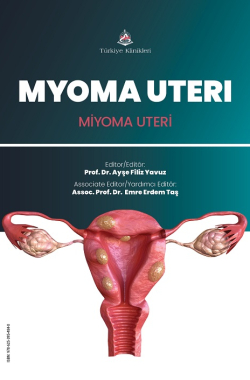Myoma Uteri and Urinary Incontinence
Gülcan Kocaoğlu¹
Gülin Feykan Yeğin2
1Ankara Etlik City Hospital, Department of Gynecology and Obstetric, Ankara, Türkiye
2Ankara Etlik City Hospital, Department of Gynecology and Obstetric, Ankara, Türkiye
Kocaoğlu G, Feykan Yeğin G. Myoma Uteri and Urinary Incontinence. Yavuz AF, ed. Myoma Uteri. 1st ed. Ankara: Türkiye Klinikleri; 2025. p.197-203.
ABSTRACT
Various types of urinary symptoms involved with fibroids, including urinary incontinence or dysuria, have been reported. Their prevalence is not well knowed and these symptoms are uncommonly researched in patients. Although fibroids are the primary reason for hysterectomies, there are few studies evaluating surgical treatment of fibroids in women with urinary symptoms.
Women who have uterine fibroids, different prevalence of urinary symptoms in varies significantly depending on whether the authors focus on symptoms or urodynamic outcomes. Urinary symptoms; dysuria (4-36%), urgency (31-59%), and stress urinary incontinence (SUI, 20-80%) are the most reported ones. While some studies have identified anterior fibroid location and fibroids larger than 5 cm as risk factors for SUI, other studies have found no correlation between fibroid topography and symptom scores.
It appears that the treatment of uterine fibroids affects urinary symptoms. Though hysterectomy is a most common cause of pelvic floor disorders, it can sometimes alleviate or treat urinary symptoms. Most authors also report a considerable recuperation in urinary symptoms following myomectomy and fibroid embolization. Further studies are required to lighten the effect of fibroid treatment on urinary symptoms.
Keywords: Leiomyoma; Fibroid; Urinary incontinence; Lower urinary tract symptoms
Kaynak Göster
Referanslar
- Buttram VC, Reiter JC. Uterine leiomyomata: etiology, symptomatology, and management. Fert Ster 1981;36(October (4)):433-45. [Crossref] [PubMed]
- Drayer SM, Catherino WH. Prevalence, morbidity, and current medical management of uterine leiomyomas. Int J Gynecol Obstetr 2015;131 (November (2)):117-22. [Crossref] [PubMed]
- Benhaim Y, Ducarme G, Madelenat P, Daraï E. Poncelet C; The limits of laparoscopic myomectomy. Gynécologie Obstétrique Fertilité 2005;33(1-2):44-9. [Crossref] [PubMed]
- Parker WH. Etiology, symptomatology, and diagnosis of uterine myomas. Fertil Steril. 2007;87(4):725-36. [Crossref] [PubMed]
- Lansac J, Lecomte P, Marret H. Gynécologie pour le praticien. 8ème ed. Issy-les- moulineaux. Elsevier Masson; 2012 (collection pour le praticien). [Link]
- Lumbiganon P, Rugpao S, Phandhu-Fung S, Laopaiboon M, Vudhikamraksa N. Werawatakul Y; Protective effect of depot-medroprogesterone acetate on surgically treated uterine leiomyomas: a multicentre case-control study. Br J Obstet Gynaecol 1996;103(9):909-14. [Crossref] [PubMed]
- Parazzini F, Negri E, La Vecchia C, Chatenoud L, Ricci E, Guarnerio P. Reproductive factors and risk of uterine broids. Epidemiology 1996;7 (4):440-2. [Crossref] [PubMed]
- Dagur G, Suh Y, Warren K, Singh N, Fitzgerald J, Khan SA. Urological complications of uterine leiomyoma: a review of literature. Int Urol Nephrol 2016;48(June (6)):941-8. [Crossref] [PubMed]
- Parker-Autry C, Harvie H, Arya LA, Northington GM. Lower urinary tract symptoms inpatientswith uterine broids: associationwith broid location and uterine volume. Female Pelvic Med Reconstr Surg 2011;17(March (2)):91-6. [Crossref] [PubMed]
- Ekin M, Cengiz H, Öztürk E, Kaya C, Yasar L, Savan K. Genitourinary symptoms and their effects on quality of life in women with uterine myomas. Int Urogynecol J 2014;25(June (6)):807-10. [Crossref] [PubMed]
- Cvach K, Dwyer P, Rosamilia A, Lim Y, Schierlitz L. A prospective observational study of lower urinary tract symptoms before and after surgical removal of a large pelvic mass. Int Urogynecology J 2015;26(Febuary (2)):201-6. [Crossref] [PubMed]
- Rivlin ME, et al. Acute urinary retention due to a free-standing broad ligament leiomyoma. J Miss State Med Assoc 1992;33(10):355-7. [PubMed]
- Andrada AO, De Vicente JMG, MÁJ Cidre. Pelvic plexus compression due to a uterine leiomyoma in a woman with acute urinary retention: a new hypothesis. Int Urogynecol J 2014;25(March (3)):429-31. [Crossref] [PubMed]
- Dragomir AD, Schroeder JC, Connolly A, Kupper LL, Cousins DS, Olshan AF, et al. Uterine leiomyomata associated with self-reported stress urinary incontinence. J Womens Health (Larchmt) 2010;19(February (2)):245-50. [Crossref] [PubMed] [PMC]
- Yazdany T, Bhatia NN, Nguyen JN. Urinary retention and voiding dysfunction in women with uterine leiomyoma: a case series. J Reprod Med. 2012;57(October (9-10)):384-9. [PubMed]
- Actualisation de la prise en charge des myomes: recommandations pour la pratique clinique - Texte des recommandations. J Gynecol Obstet Biol Reprod 2011;40:693-962. [Crossref] [PubMed]
- Milsom I, Ekelund P, Molander U, Arvidsson L, Areskoug B. The inuence of age parity oral contraception, hysterectomy and menopause on the prevalence of urinary incontinence in women. J Urol 1993;149:1459-62. [Crossref] [PubMed]
- Parys BT, Woolfenden KA, Parsons KF. Bladder dysfunction after simple hysterectomy: urodynamic and neurological evaluation. Eur Urol 1990;17:129-33. [Crossref] [PubMed]
- van der Vaart CH, van der Bom JG, de Leeuw JR, Roovers JP, Heintz AP. The contribution of hysterectomy to the occurrence of urge and stress urinary incontinence symptoms. Br J Obstet Gynaecol 2002;109:149-54. [Crossref] [PubMed]
- Bohlin KS, Ankardal M, Lindkvist H, Milsom I. Factors inuencing the incidence and remission of urinary incontinence after hysterectomy. Am J Obstet Gynecol. 2017 Sep;1. [Crossref] [PubMed]
- Altman D, Lopez A, Falconer C, Zetterstrom J. The impact of hysterectomy on lower urinary tract symptoms. Int Urogynecol J Pelvic Floor Dysfunct. 2003;14 (December (6)):418-23. [Crossref] [PubMed]
- Shveiky D, Iglesia CB, Antosh DD, Kudish BI, Peterson J, Huang C-C, et al. The effect of uterine broid embolization on lower urinary tract symptoms. Int Urogynecol J2013;24(August (8)):1341-5. [Crossref] [PubMed]
- Arleo EK, Tal MG. Fibroid-induced acute urinary retention: treatment by uterine artery embolization. Int Urogynecol J Pelvic Floor Dysfunct 2008;19 (January (1)):161-5 [Crossref] [PubMed]

